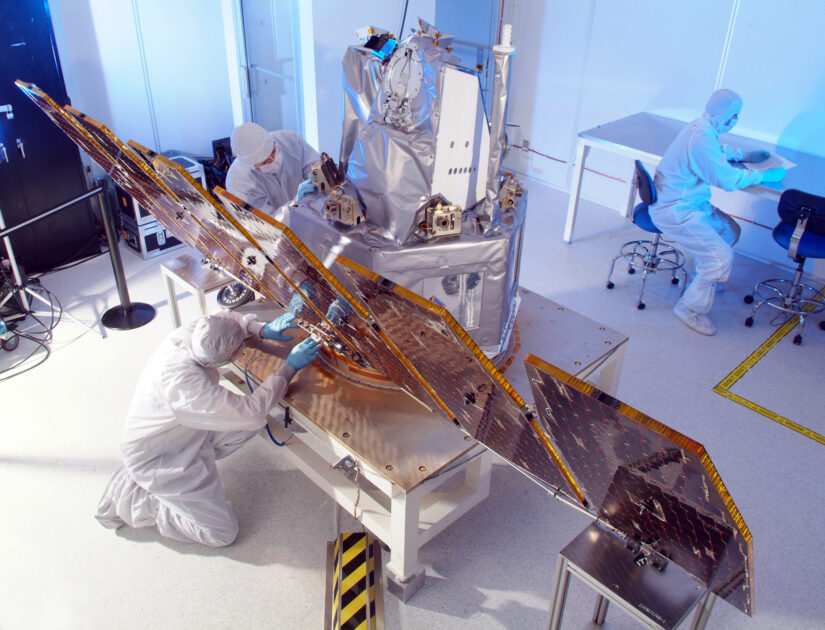NASA’s First Satellite Mission Led by an HBCU Marks Anniversary Milestone
HAMPTON, Va. (April 15, 2025) – Eighteen years ago this month, Hampton University reached for the stars—quite literally—motivated by a desire to answer fundamental questions about Earth’s changing atmosphere. At a time when global concern about climate change and its long-term consequences was mounting, the university sought to elevate its voice in the scientific community, disrupt the status quo in aerospace research, and offer students from underrepresented backgrounds a front-row seat to history.
This month celebrates the groundbreaking success and enduring impact of the Aeronomy of Ice in the Mesosphere (AIM) mission, the first NASA satellite mission led by a Historically Black College and University (HBCU). Launched on April 25, 2007, AIM significantly advanced scientific understanding of noctilucent clouds (NLCs) and their role in climate dynamics before concluding its mission in August 2024.

Under the leadership of Dr. James M. Russell III (pictured), former Director of Hampton’s Center for Atmospheric Sciences, AIM was designed to investigate the mysterious formation and behavior of these wispy, glowing clouds that form near the edge of space. The mission yielded invaluable insights into atmospheric temperature shifts, solar radiation, and greenhouse gas effects, laying the groundwork for new models of Earth’s upper atmosphere.
But perhaps AIM’s most lasting impact lies in the people it inspired.
Over the course of the mission, more than 60 Hampton University undergraduate and graduate students gained hands-on research experience through the AIM project—many for the first time. Students worked alongside top scientists and engineers, contributed to peer-reviewed papers, and presented findings at international conferences. Several alumni have gone on to earn Ph.D.s in atmospheric sciences, work at NASA centers across the country, or teach in STEM fields, helping to diversify and strengthen the national scientific workforce.
“AIM was not just a scientific milestone—it was a catalyst for opportunity,” said Dr. Isi Ero-Johnson, Dean of the School of Science. “Our students became published researchers, policy advisors, and space scientists. They saw what was possible when a university like Hampton believes in its capacity to lead.”
The AIM mission was a collaboration of innovation and excellence, supported by NASA, the University of Colorado’s Laboratory for Atmospheric and Space Physics (LASP), Virginia Tech, and industry partners including Orbital Sciences Corporation and Global Atmospheric Technologies (GATS), Inc. At its core, AIM embodied Hampton’s commitment to academic rigor, scientific discovery, and inclusive excellence.
“This mission exemplifies the strength of Hampton University’s research community and its ability to lead transformative scientific initiatives,” said Ero-Johnson. “AIM has not only advanced our understanding of atmospheric science but also provided invaluable opportunities for our students and faculty to contribute to cutting-edge research.”

The AIM mission was a collaborative effort, with critical support from NASA, the University of Colorado’s Laboratory for Atmospheric and Space Physics (LASP), Virginia Tech, and industry partners such as Orbital Sciences Corporation and Global Atmospheric Technologies (GATS), Inc. The mission also played a pivotal role in training and mentoring the next generation of atmospheric scientists and engineers at Hampton University.
“It has been a pleasure and a privilege to work with the dedicated and talented AIM team, which combined NASA, university and industry partners to enable the groundbreaking success of the AIM mission,” said Dr. Robert Loughman, chair of the department of Atmospheric and Planetary Sciences. “We’re honored that Hampton University served as the lead institution and proud of the role we continue to play in preparing the next generation of atmospheric scientists.”
Over its nearly 15-year operational period, AIM delivered groundbreaking data on atmospheric temperature variations, solar influences, and the effects of greenhouse gases. The mission’s scientific contributions are evidenced by nearly 400 published research papers, with ongoing studies utilizing AIM’s extensive data archive.
As the world continues to grapple with the consequences of a changing climate, Hampton University remains a vital contributor to atmospheric science and space exploration, offering a model for what’s possible when vision meets access and excellence meets opportunity.
About Hampton University
Hampton University is a Carnegie R2-designated research institution, recognized for its groundbreaking research in atmospheric science, cancer treatment, and cybersecurity. Contributing $530 million annually to the regional and Commonwealth of Virginia economies, Hampton plays a vital role in driving economic development while championing diversity, inclusion, and opportunity. The university was recently named one of the “Best Colleges in America” by Money Magazine and recognized as the “Best Private College” by Coastal Virginia.
Founded in 1868, Hampton University is a close-knit community of learners and educators, representing 44 states and 32 territories, committed to nurturing intellectual curiosity, critical thinking, and global citizenship. For more information, visit www.hamptonu.edu.
For media inquiries regarding Hampton University, please contact Mahogany Waldon in the Office of University Relations at mahogany.waldon@hamptonu.edu or 757-727-5253.
![]()
